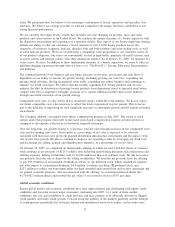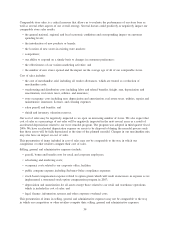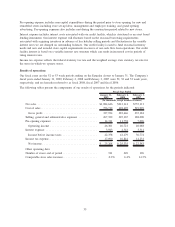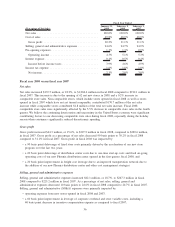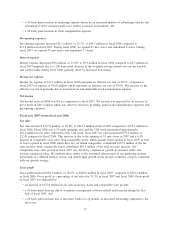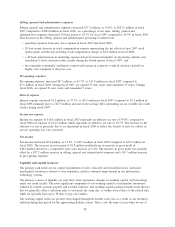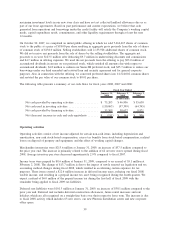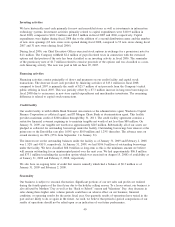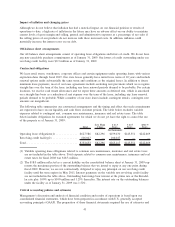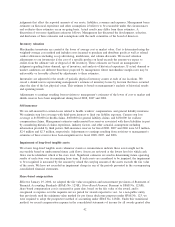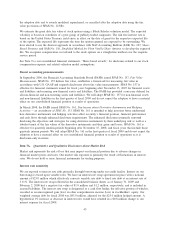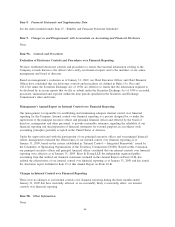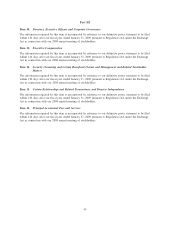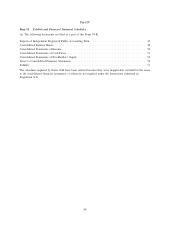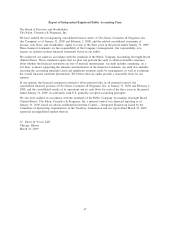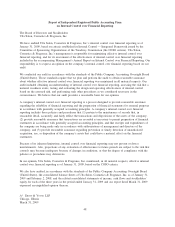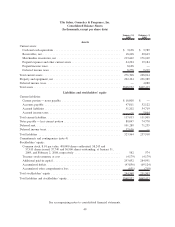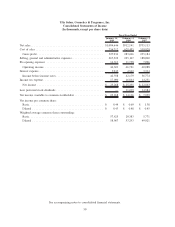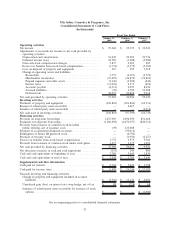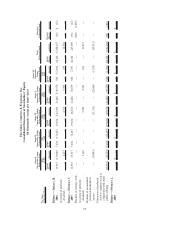Ulta 2008 Annual Report Download - page 48
Download and view the complete annual report
Please find page 48 of the 2008 Ulta annual report below. You can navigate through the pages in the report by either clicking on the pages listed below, or by using the keyword search tool below to find specific information within the annual report.judgments that affect the reported amounts of our assets, liabilities, revenues and expenses. Management bases
estimates on historical experience and other assumptions it believes to be reasonable under the circumstances
and evaluates these estimates on an on-going basis. Actual results may differ from these estimates. A
discussion of our more significant estimates follows. Management has discussed the development, selection,
and disclosure of these estimates and assumptions with the audit committee of the board of directors.
Inventory valuation
Merchandise inventories are carried at the lower of average cost or market value. Cost is determined using the
weighted-average cost method and includes costs incurred to purchase and distribute goods as well as related
vendor allowances including co-op advertising, markdowns, and volume discounts. We record valuation
adjustments to our inventories if the cost of a specific product on hand exceeds the amount we expect to
realize from the ultimate sale or disposal of the inventory. These estimates are based on management’s
judgment regarding future demand, age of inventory, and analysis of historical experience. If actual demand or
market conditions are different than those projected by management, future merchandise margin rates may be
unfavorably or favorably affected by adjustments to these estimates.
Inventories are adjusted for the results of periodic physical inventory counts at each of our locations. We
record a shrink reserve representing management’s estimate of inventory losses by location that have occurred
since the date of the last physical count. This estimate is based on management’s analysis of historical results
and operating trends.
Adjustments to earnings resulting from revisions to management’s estimates of the lower of cost or market and
shrink reserves have been insignificant during fiscal 2008, 2007 and 2006.
Self-insurance
We are self-insured for certain losses related to health, workers’ compensation, and general liability insurance.
We maintain stop loss coverage with third-party insurers to limit our liability exposure. Current stop loss
coverage is $150,000 for health claims, $100,000 for general liability claims, and $250,000 for workers’
compensation claims. Management estimates undiscounted loss reserves associated with these liabilities in part
by considering historical claims experience, industry factors, and other actuarial assumptions including
information provided by third parties. Self-insurance reserves for fiscal 2008, 2007 and 2006 were $1.9 million,
$2.4 million and $2.3 million, respectively. Adjustments to earnings resulting from revisions to management’s
estimates of these reserves have been insignificant for fiscal 2008, 2007, and 2006.
Impairment of long-lived tangible assets
We review long-lived tangible assets whenever events or circumstances indicate these assets might not be
recoverable based on undiscounted future cash flows. Assets are reviewed at the lowest level for which cash
flows can be identified, which is the store level. Significant estimates are used in determining future operating
results of each store over its remaining lease term. If such assets are considered to be impaired, the impairment
to be recognized is measured by the amount by which the carrying amount of the assets exceeds the fair value
of the assets. We have not recorded an impairment charge in any of the periods presented in the accompanying
consolidated financial statements.
Share-based compensation
Effective January 29, 2006, we adopted the fair value recognition and measurement provisions of Statement of
Financial Accounting Standards (SFAS) No. 123(R), Share-Based Payment. Pursuant to SFAS No. 123(R),
share-based compensation cost is measured at grant date, based on the fair value of the award, and is
recognized as expense over the requisite service period for awards expected to vest. As a non-public entity
that previously used the minimum value method for pro forma disclosure purposes under SFAS No. 123, we
were required to adopt the prospective method of accounting under SFAS No. 123(R). Under this transitional
method, we record compensation expense in the consolidated statements of income for all awards granted after
42


